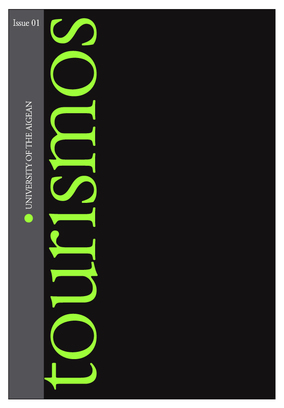Mechanism of social capital in community tourism participatory planning in Samui island, Thailand
Part of : Tourismos : an international multidiciplinary journal of tourism ; Vol.7, No.1, 2012, pages 339-349
Issue:
Pages:
339-349
Section Title:
Case studies
Abstract:
Community participation as a strategy for local tourism development has become an important mechanism to promote sustainable tourism. This paper explores community participatory planning process in local tourism development on Samui Island, Thailand. Factors associated with participation of local people were examined in decision-making, implementation, and monitoring and evaluation phases. Result showed social capital as a driver in various stages can be considered as crucial mechanism for the success of the planning for local tourism activities.
Subject:
Subject (LC):
Keywords:
community participation, social capital, tourism planning
Notes:
Περιέχει πίνακες και βιβλιογραφία
References (1):
- Anderson, C., Locker, L. & Nugent, R. (2002). Microcredit, Social Capital and Common Pool Resources. World Development, Vol. 30, pp.95-105.Aronsson, L. (2000). Sustainable Tourism Development: The Development of Sustainable Tourism. New York, Continuum.Ashley, C., Roe, D. & Goodwin, H. (2001). Pro-Poor Tourism Strategies: Making Tourism Work for the Poor. Nottingham, Overseas Development Institution.Chambers, R. (1983). Rural Development: Putting the Last First. London, Longman.Chambers, R. (1997). Whose Reality Counts? Putting the Last First. London, IT Publications.Chauhan, V. & Khanna, S. (2009). Tourism: A Tool for Crafting Peace Process in Kashmir, J&K, India. Tourismos: An International Multidisciplinary Journal of Tourism, Vol. 4, No.2, pp.69-89.Galdini, R. (2007). Tourism and the City: Opportunity for Regeneration. Tourismos: An International Multidisciplinary Journal of Tourism, Vol. 2, No.2, pp.95-111.Garrod, B. (2003). Local Participation in the Planning and Management of Ecotourism: A Revised Model Approach. Journal of Ecotourism, Vol. 2, No.1, pp.33-53.Gibbons, M. (1999). Science’s New Social Contract with Society. Nature, Vol. 402, C81-C84.Harpham, T., Grant, E. & Thomas, E. (2002). Measuring Social Capital Within Health Surveys: Key Issues. Health Policy and Planning, Vol. 17, pp.106-111.International Council for Local Environmental Initiatives (ICLEI). (1999). Sustainable Tourism: A Local Authority Perspective. Department of Economic and Social Affairs. New York, United Nations.Jamal, T.B. & Getz, D. (1995). Collaboration Theory and Community Tourism Planning. Annals of Tourism Research, Vol. 22, No.1, pp.205-217.Jones, S. (2005). Community-Based Ecotourism: The Significance of Social Capital. Annals of Tourism Research, Vol. 32, No.2, pp.303-324Leach, W.D. (2002). Surveying Diverse Stakeholder Groups. Society Natural Resources, Vol. 15, pp.641-649Macbeth, J., Carson, D. & Northcote, J. (2004). Social Capital, Tourism and Regional Development: SPCC as a Basic for Innovation and Sustainability. Current Issues in Tourism, Vol. 7, No.6, pp.502-522.Mansuri, G. & Rao, V. (2004). Community-Based and Driven Development: A Critical Review. The World Bank Research Observer, Vol. 19, No.1, pp.1-39.Narayanan, P. (2003). Empowerment through Participation. How Effective is this Approach? Economic and Political Weekly, June 21, Vol. 38, No.25.Oppermann, M. (1993). Tourism Space in Developing Countries. Annals of Tourism Research, Vol. 20, pp.535-556.Parkins, J.R. & Mitchell, R.E. (2005). Public Participation as Public Debate: A Deliberative Turn in Natural Resource Management. Society and Natural Resources, Vol. 18, pp.529-540.Pearce, P.L., Moscardo, G. & Ross, G.F. (1996). Tourism Community Relationships. Pergamon.Plummer, R. & FitzGibbon, J. (2006). People Matter: The Importance of Social capital in the Co-Management of Natural Resources. Natural Resources Forum, Vol. 30, pp.51-62.Pongponrat, K. (2006). Initiation of Participatory Tourism Planning by Local Government: A Case Study of Community Cleaning Day, Samui Island, Surat Thani Province, Southern Thailand. Journal of Hospitality and Tourism, Vol. 4, No.2, pp.65-89.Putman, R.D. (1993). The Prosperous Community: Social Capital and Public Life. The American Prospect, Vol.13.Richins, H. & Scarinci, J. (2009). Climate Change and Sustainable Practices: A Case Study of the Resort Industry in Florida. Tourismos: An International Multidisciplinary Journal of Tourism. Vol. 4, No.2, pp.107-128.Singh, T.V. (1989). The Kulu Valley: Impact of Tourism Development in the Mountain Areas. New Delhi, Himalayan Books.Sirisongkram, P., Sitiwathanarukul, Y. & Pattamarakha, K. (1999). Members Participation in Cooperative Activities. Thaksin University Journal, Vol. 2, No.2, pp.60-76.Tambon Municipality of Samui Island. (2007). The Five- Year Development Plan. Thailand: Municipality of Samui Island.Tandon, R. (2002). Linking Citizenship, Participation, and Accountability: A Perspective from PRIA. IDS Bulletin, Vol. 33, No.2.Tourism Authority of Thailand. (2007). Thailand Tourism Statistics. Bangkok.Voelker, J.W. (1998). The Ongoye Forest Ecotourism Venture-Assessing the Feasibility. Kassel.Woolcock, M. (1998). Social Capital and Economic Development: Toward a Theoretical Synthesis and Policy Framework. Theory and Society, Vol. 27, pp.151-208.




